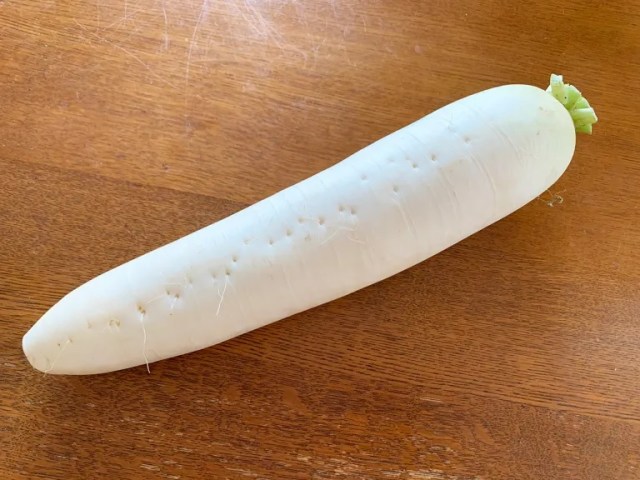
A cross-cultural conversation helps Seiji rediscover one of his favorite dishes from his childhood.
“Hey, so I heard you don’t have daikon is America. Is that true?”
That’s the question my coworker Seiji asked me at the start of the workday, wanting to confirm something he’d heard online. “Yeah, daikon isn’t really a thing in the U.S.,” I told him. “Like, you can find it in some Asian specialty markets, but most people haven’t ever eaten, seen, or really heard of it.”
▼ Daikon, shown by the arrow here, can be found at pretty much any grocery store in Japan.
“I was reading about someone from overseas who saw daikon for the first time while visiting a supermarket in Japan,” Seiji continued, “and they said they had no idea how they were supposed to prepare it.”
“Makes sense,” I replied. “I mean, there aren’t any standard American recipes that use daikon, and radishes in general don’t show up in a ton of American dishes anyway, so figuring out what to do with a whole daikon would probably be a head-scratcher.”
So Seiji, helpful guy that he is, decided he wanted to share an easy recipe to serve as an introduction to daikon for anyone who didn’t grow up eating it. The easiest method of all would be just to slice the daikon into thin strips and toss them in a salad with an assortment of other vegetables, but Seiji wanted to present something a little more interesting, so he went out to find the perfect recipe for daikon newbies…and when we say he went out, what we really mean is he went home and asked his mom.
▼ With Seiji being the biggest otaku on our staff, you might look at this photo of his mom and come to the conclusion that he was literally born from an anime character, but actually she’s just too shy to let her face be photographed.
Seiji’s mom cooked daikon dishes for the family a lot when he was growing up, and even now he can count on at least one serving of daikon whenever he goes home to visit for a few days. So he asked her for a simple recipe, and she was happy to share with us how to make her delicious “Boiled-Up Daikon and Chicken” (not the catchiest name, but even though she’s cooked it a hundred times, she’d never thought about what to call it until Seiji asked her).
For the ingredients, you’ll need:
● Daikon
● Chicken
● Soy sauce, bonito stock, sake, mirin, and/or ginger
Step 1
Start by making a small incision in the daikon, about one centimeter (a little under half an inch) deep. The outer layer is too tough to eat, so after you’ve made the incision go ahead and peel it off.
Step 2
Slice the daikon into discs, then slice those discs into fourths, so that you have a bunch of little quarter-circles.
Step 3
Place the daikon chunks on a plate, cover with plastic wrap, and cook in the microwave for five minutes. If you want to get really old-school, you can instead boil the daikon in a pot using the leftover water from washing a pot of white rice prior to cooking, but with how much quicker and easier it is to use the microwave, that’s the route Seiji’s mom usually goes with.
Step 4
While the daikon is cooking, cut the chicken into bite-sized pieces. Brown them in a frying pan, then drain off the oil (but keep the chicken in the pan).
Step 5
When the daikon is done microwaving, add the pieces to the frying pan with the chicken. Pour in 400 milliliters (13.5 ounces) of water, then place a cover on the pan and let it cook with a slightly low flame for a while, until the daikon softens up and you can easily pierce it with a toothpick (for this batch, that took somewhere around 8 or 10 minutes).
Step 6
Remove the lid and skim off any lye that’s solidified and risen to the surface of the water.
Step 7
Add in whichever of the seasonings listed above that you feel like. For a batch with 400 milliliters of water like this one, Seiji’s mom recommends two tablespoons each of soy sauce, sake, and mirin, one packet of bonito stock (generally about 8 grams [0.3 ounces]), and half a tablespoon of grated ginger or ginger paste.
Step 8
Put the lid back on the frying pan and let it cook until the liquid is gone…
…and it’s ready to eat!
It may not be fancy, but that doesn’t mean it’s not delicious. It’s a simple but straightforward flavor, hearty and filling without being heavy or bloating, and the ginger gives it just a touch of mature complexity. And if you want to get fancy with it, you can add or swap all sorts of ingredients. While she always uses daikon, Seiji’s mom has also thrown pork, carrots, and eggplant into the mix, all with tasty results.
Though Seiji had already eaten this dish tons of times back when he lived with his parents, he’d never tried cooking it himself before this. He’s now making it a part of his regular home-cooking meal rotation, so while his original goal was to introduce the recipe to all of you, it turned out to be a reintroduction for him too, and he hopes you’ll enjoy cooking and eating it as much as he does.
Photos ©SoraNews24
● Want to hear about SoraNews24’s latest articles as soon as they’re published? Follow us on Facebook and Twitter!



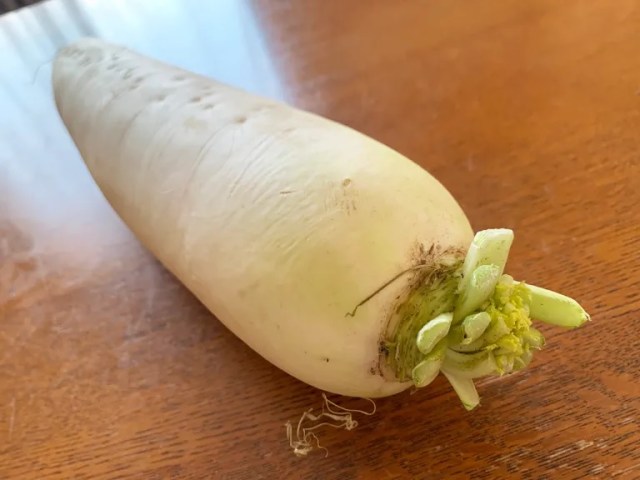
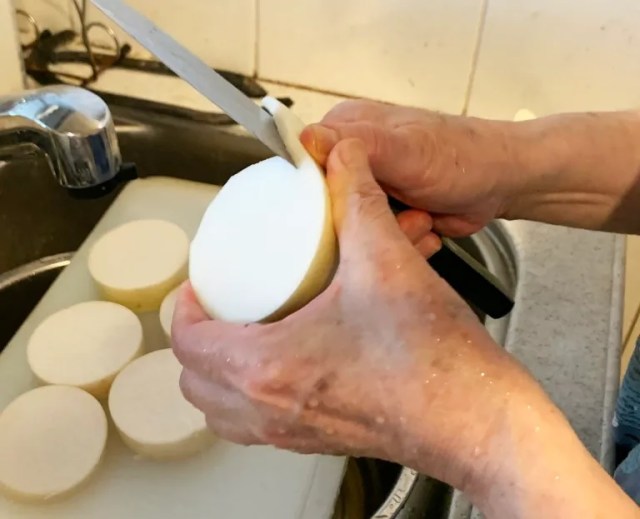
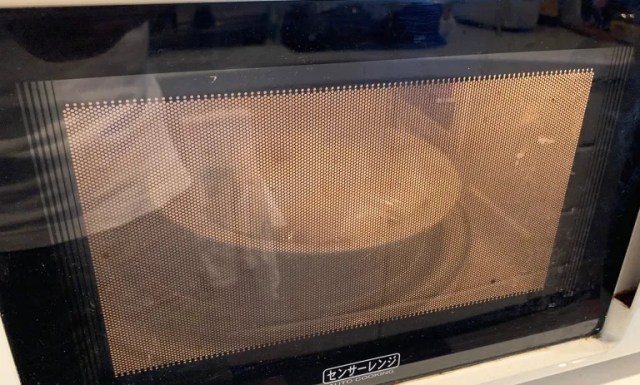

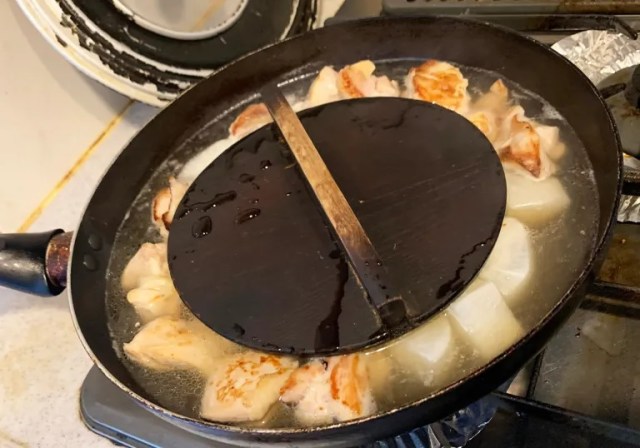
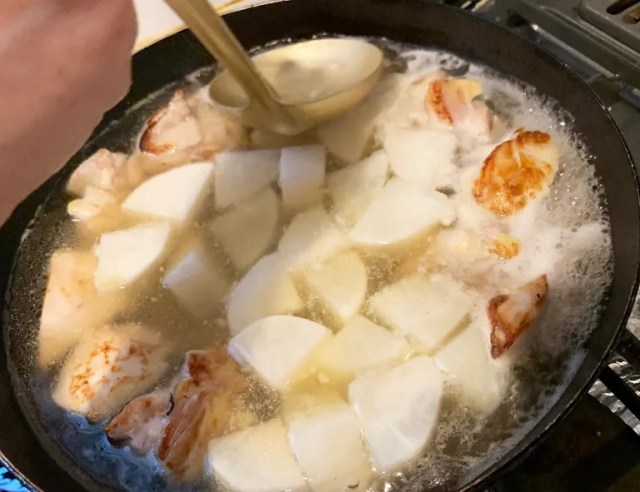
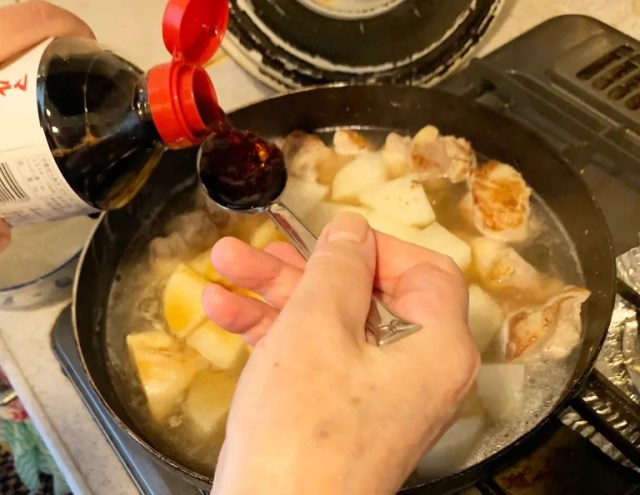
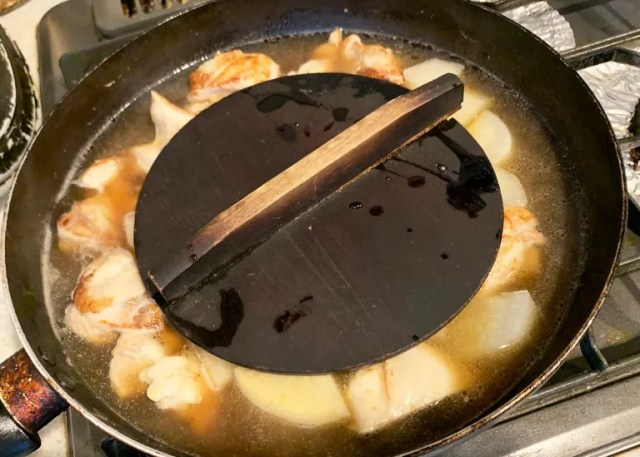
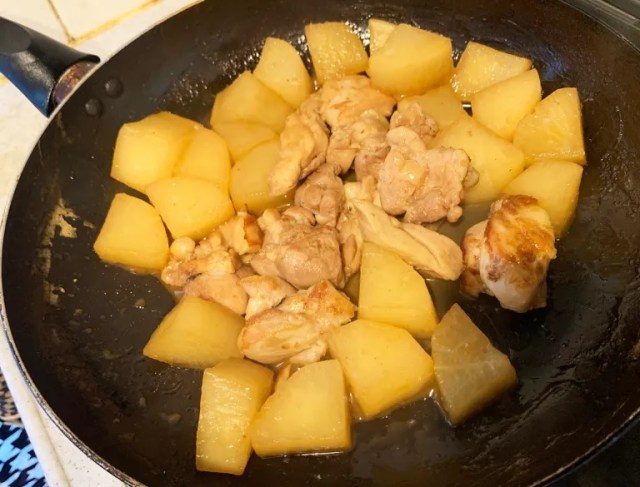
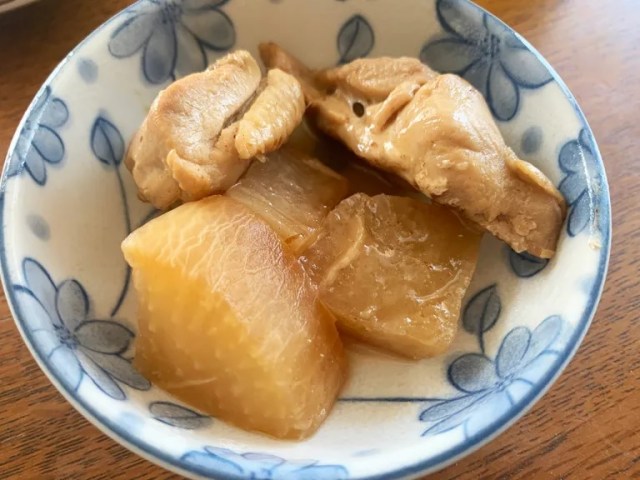
 Learn to love the taste of raw daikon with this simple recipe 【RocketKitchen】
Learn to love the taste of raw daikon with this simple recipe 【RocketKitchen】 Hungry for love – 10 dishes Japanese men want their girlfriends to cook for them
Hungry for love – 10 dishes Japanese men want their girlfriends to cook for them Try a super-easy summer cold remedy with this natural Honey Daikon Cough Syrup recipe
Try a super-easy summer cold remedy with this natural Honey Daikon Cough Syrup recipe World’s largest type of daikon radish can now be ordered online in Japan
World’s largest type of daikon radish can now be ordered online in Japan We create a Japanese izakaya pub at home with an amazing all-in-one kitchen gadget
We create a Japanese izakaya pub at home with an amazing all-in-one kitchen gadget Bad tourist manners at Mt Fuji Lawson photo spot prompts Japanese town to block view with screens
Bad tourist manners at Mt Fuji Lawson photo spot prompts Japanese town to block view with screens McDonald’s Japan’s new pancake pie is a taste sensation
McDonald’s Japan’s new pancake pie is a taste sensation Foreigner’s request for help in Tokyo makes us sad for the state of society
Foreigner’s request for help in Tokyo makes us sad for the state of society Two things to do, and two things not to do, when leaving a traditional Japanese inn
Two things to do, and two things not to do, when leaving a traditional Japanese inn One of Japan’s oldest castles now lets travelers spend night on the grounds, drink in its keep
One of Japan’s oldest castles now lets travelers spend night on the grounds, drink in its keep History’s largest force of Samurai Colonel Sanders deploying to KFC Japan branches
History’s largest force of Samurai Colonel Sanders deploying to KFC Japan branches Studio Ghibli unveils massive T-shirt collection featuring top anime movie characters
Studio Ghibli unveils massive T-shirt collection featuring top anime movie characters Studio Ghibli unveils new goods that tip the hat to The Cat Returns
Studio Ghibli unveils new goods that tip the hat to The Cat Returns FUK COFFEE?!? Japanese cafe has a perfectly innocent reason for its startling-looking name
FUK COFFEE?!? Japanese cafe has a perfectly innocent reason for its startling-looking name All-you-can-drink Starbucks and amazing views part of Tokyo’s new 170 meter-high sky lounge
All-you-can-drink Starbucks and amazing views part of Tokyo’s new 170 meter-high sky lounge Red light district sushi restaurant in Tokyo shows us just how wrong we were about it
Red light district sushi restaurant in Tokyo shows us just how wrong we were about it Japanese city loses residents’ personal data, which was on paper being transported on a windy day
Japanese city loses residents’ personal data, which was on paper being transported on a windy day McDonald’s new Happy Meals offer up cute and practical Sanrio lifestyle goods
McDonald’s new Happy Meals offer up cute and practical Sanrio lifestyle goods Japanese ramen restaurants under pressure from new yen banknotes
Japanese ramen restaurants under pressure from new yen banknotes Ghibli Park now selling “Grilled Frogs” from food cart in Valley of Witches
Ghibli Park now selling “Grilled Frogs” from food cart in Valley of Witches New definition of “Japanese whiskey” goes into effect to prevent fakes from fooling overseas buyers
New definition of “Japanese whiskey” goes into effect to prevent fakes from fooling overseas buyers Our Japanese reporter visits Costco in the U.S., finds super American and very Japanese things
Our Japanese reporter visits Costco in the U.S., finds super American and very Japanese things More foreign tourists than ever before in history visited Japan last month
More foreign tourists than ever before in history visited Japan last month New Pokémon cakes let you eat your way through Pikachu and all the Eevee evolutions
New Pokémon cakes let you eat your way through Pikachu and all the Eevee evolutions Disney princesses get official manga makeovers for Manga Princess Cafe opening in Tokyo
Disney princesses get official manga makeovers for Manga Princess Cafe opening in Tokyo French Fries Bread in Tokyo’s Shibuya becomes a hit on social media
French Fries Bread in Tokyo’s Shibuya becomes a hit on social media Sales of Japan’s most convenient train ticket/shopping payment cards suspended indefinitely
Sales of Japan’s most convenient train ticket/shopping payment cards suspended indefinitely Sold-out Studio Ghibli desktop humidifiers are back so Totoro can help you through the dry season
Sold-out Studio Ghibli desktop humidifiers are back so Totoro can help you through the dry season Japanese government to make first change to romanization spelling rules since the 1950s
Japanese government to make first change to romanization spelling rules since the 1950s Ghibli founders Toshio Suzuki and Hayao Miyazaki contribute to Japanese whisky Totoro label design
Ghibli founders Toshio Suzuki and Hayao Miyazaki contribute to Japanese whisky Totoro label design Doraemon found buried at sea as scene from 1993 anime becomes real life【Photos】
Doraemon found buried at sea as scene from 1993 anime becomes real life【Photos】 Tokyo’s most famous Starbucks is closed
Tokyo’s most famous Starbucks is closed One Piece characters’ nationalities revealed, but fans have mixed opinions
One Piece characters’ nationalities revealed, but fans have mixed opinions We asked a Uniqlo employee what four things we should buy and their suggestions didn’t disappoint
We asked a Uniqlo employee what four things we should buy and their suggestions didn’t disappoint Do try this at home! 5 foods that you can recreate in taste by combining other foods
Do try this at home! 5 foods that you can recreate in taste by combining other foods Are 100 yen shop Daiso’s Japanese radish seeds worth your time? Let’s find out【Experiment】
Are 100 yen shop Daiso’s Japanese radish seeds worth your time? Let’s find out【Experiment】 What’s really for breakfast? 20 Japanese people give us a peek at their morning meal【Photos】
What’s really for breakfast? 20 Japanese people give us a peek at their morning meal【Photos】 Grated radish art from Japan brings the cute to your favourite dishes
Grated radish art from Japan brings the cute to your favourite dishes Japanese cook creates adorable meal of “cats” feasting on fish!
Japanese cook creates adorable meal of “cats” feasting on fish! East meet West in kitchen as Japanese ingredient makes Western-style cream stew more delicious
East meet West in kitchen as Japanese ingredient makes Western-style cream stew more delicious What happens when you cook beer with potato chips in a rice cooker?
What happens when you cook beer with potato chips in a rice cooker? How to make a shaved ice dessert out of instant noodles
How to make a shaved ice dessert out of instant noodles We make Dom Dom Burger’s Sweet and Salty Chicken Burger from scratch【SoraKitchen】
We make Dom Dom Burger’s Sweet and Salty Chicken Burger from scratch【SoraKitchen】 We try cooking yakisoba with real Japanese buckwheat soba【SoraKitchen】
We try cooking yakisoba with real Japanese buckwheat soba【SoraKitchen】 We try Burger King Japan’s CooKING Burger @Home, use up lots of stuff in our fridge
We try Burger King Japan’s CooKING Burger @Home, use up lots of stuff in our fridge Ramen egg showdown! Which Japanese convenience store makes the best nitamago?【Taste test】
Ramen egg showdown! Which Japanese convenience store makes the best nitamago?【Taste test】 Which convenience store has the best kakuni Japanese braised pork? We find out【Taste test】
Which convenience store has the best kakuni Japanese braised pork? We find out【Taste test】 New book teaches you to make grated radish animals: Healthier than latte art, just as cute
New book teaches you to make grated radish animals: Healthier than latte art, just as cute Can you guess the most-consumed vegetable in Japan? This survey reveals the results
Can you guess the most-consumed vegetable in Japan? This survey reveals the results Agedashi…doughnuts? Traditional Japanese tofu dish gets a sweet twist from Mister Donut
Agedashi…doughnuts? Traditional Japanese tofu dish gets a sweet twist from Mister Donut
Leave a Reply